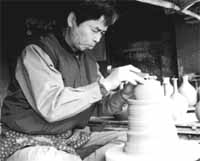A tougher stand
 ceramic products are a versatile lot, and enjoy a wide range of scientific, domestic and industrial applications. Without ceramics, ordinary household tiles, microchips and state-of-the-art superconductors, for instance, would not have been possible. They are also cheap to produce on a large scale and would become every physicist's dream if only they were tougher. Their main drawback lies in the fact that they are very brittle, and can collapse under the slightest pressure with little or no resistance at all. The discovery of a method to strengthen ceramics could give material physics a big boost and revolutionise other fields of research such as superconductivity and microchip design and production.
ceramic products are a versatile lot, and enjoy a wide range of scientific, domestic and industrial applications. Without ceramics, ordinary household tiles, microchips and state-of-the-art superconductors, for instance, would not have been possible. They are also cheap to produce on a large scale and would become every physicist's dream if only they were tougher. Their main drawback lies in the fact that they are very brittle, and can collapse under the slightest pressure with little or no resistance at all. The discovery of a method to strengthen ceramics could give material physics a big boost and revolutionise other fields of research such as superconductivity and microchip design and production.
Now, T Ishikawa and his team from Ube Research laboratory, Japan, have come upon a way to make common silicon much tougher by using a silicon carbide composite. Their approach, if successful for other materials too, could soon bring about a revolution in ceramic-related applications.
Ceramics include all inorganic, non-metallic solids, which enjoy industrial applications. Commonly, they are compounds of metallic elements and oxygen, but many, especially advanced ceramics, are compounds of metals and carbon, nitrogen, or sulphur. They usually have crystalline atomic structures, though some may also contain a combination of glassy and crystalline phases. These structures and chemical ingredients, though innumerable, result in properties ceramics are well known for. These include enduring utility, mechanical strength despite brittleness and resistance to the degrading effects of oxygen, water, acids, bases, salts, and organic solvents. Further, most ceramics are durable, resisting wear and tear and have low heat and electrical conductivity. Their ability to allow decorative finishes, makes them perfect for use as tiles.
Ceramic products are brittle because the paucity of dislocations in their crystal structure. Scientists know two ways of combating this brittleness. One method is to take long ceramic fibres and incorporate them in silicon carbide so that the resultant composite is tougher than the individual materials. However, this method depends extensively on the interface between the two materials. Another way is to improve the material's strength by creating a new internal structure within the material itself. This is what Ishikawa and his group have done. Using silicon carbide, Ishikawa and his colleagues have created a composite material, which is stronger and can resist temperatures of up to 1,400
